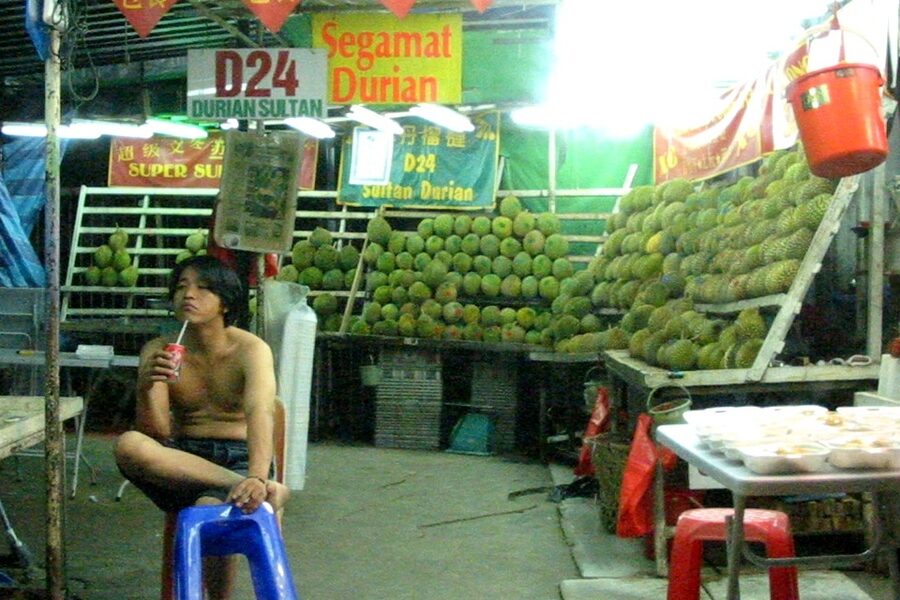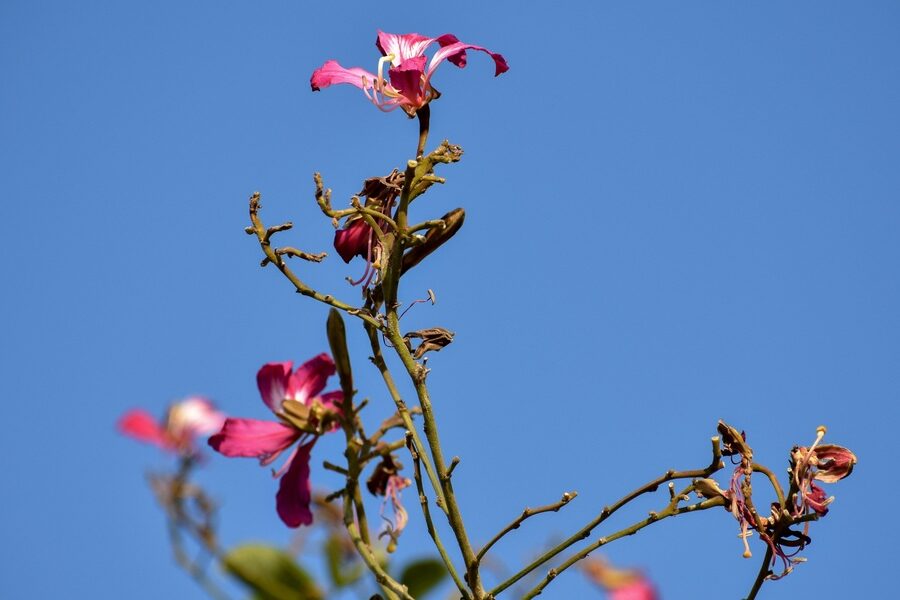Congaree National Park in South Carolina preserves one of the largest intact bottomland hardwood forests in the United States, where longleaf sloughs, floodplain swamps and a dense canopy create varied planting zones and seasonal changes that affect what you see on a hike.
There are 39 Congaree National Park Plants, ranging from American holly to Willow oak. For each species, the list is organized with the columns Scientific name, Typical height (m), Habitat / where in park to help you recognize and locate them, which you’ll find below.
When is the best time to see the most plant diversity in Congaree National Park?
Spring and early summer show the greatest variety of understory wildflowers and new leaf growth, while late summer brings full canopy cover and wet-weather species; fall can highlight a different set of colors and seeds—check recent flood conditions and trail closures before you go.
How should I use the table to identify trees and shrubs on the trails?
Use the Scientific name for exact identification, compare Typical height (m) to what you observe, and match the listed Habitat / where in park to the trail section you’re on; taking clear photos of leaves, bark and fruit and cross-referencing with the table makes field ID much easier.
Congaree National Park Plants
| Common name | Scientific name | Typical height (m) | Habitat / where in park |
|---|---|---|---|
| Bald cypress | Taxodium distichum | 20–35 m | floodplain, swamp, boardwalk |
| Water tupelo | Nyssa aquatica | 15–25 m | deep swamp, flooded pools |
| Blackgum (Black tupelo) | Nyssa sylvatica | 10–25 m | levee edges, upland pockets |
| Sweetgum | Liquidambar styraciflua | 15–35 m | floodplain, levee, mixed canopy |
| Loblolly pine | Pinus taeda | 25–40 m | higher ground, levee ridges |
| Red maple | Acer rubrum | 10–25 m | throughout, flooded to upland |
| River birch | Betula nigra | 10–20 m | levee banks, stream edges |
| American holly | Ilex opaca | 5–15 m | understory, levee and edges |
| Flowering dogwood | Cornus florida | 5–10 m | levee, understory, boardwalk edges |
| Pawpaw | Asimina triloba | 2–6 m | shady understory, boardwalk edges |
| Spicebush | Lindera benzoin | 1–3 m | understory, swamp edges, levee margins |
| Switchcane | Arundinaria gigantea | 1–3 m | riverbanks, levee, cane breaks |
| Buttonbush | Cephalanthus occidentalis | 1–4 m | standing water margins, swamp edges |
| Poison sumac | Toxicodendron vernix | 3–10 m | wet swales, flooded depressions |
| Poison ivy | Toxicodendron radicans | 0.2–8 m | throughout, climbs trees and fences |
| Wax myrtle | Morella cerifera | 1–5 m | levees, scrubby high spots, edges |
| Laurel greenbrier | Smilax laurifolia | 1–5 m vine | swamp understory, dense thickets |
| Muscadine grape | Vitis rotundifolia | vine to 10 m | edges, treetops, levee |
| American hornbeam | Carpinus caroliniana | 6–12 m | levee and shaded understory |
| Sassafras | Sassafras albidum | 6–12 m | levee, higher ground pockets |
| Sweetbay magnolia | Magnolia virginiana | 3–10 m | swamp margins, floodplain edges |
| Swamp chestnut oak | Quercus michauxii | 20–30 m | levee ridges, higher hummocks |
| Willow oak | Quercus phellos | 15–25 m | levee, floodplain edges |
| Water oak | Quercus nigra | 10–25 m | floodplain edges, levee margins |
| Overcup oak | Quercus lyrata | 15–25 m | frequently flooded depressions |
| Cherrybark oak | Quercus pagoda | 20–35 m | levee and higher floodplain ridges |
| Green ash | Fraxinus pennsylvanica | 15–25 m | stream banks, levee edges |
| Black willow | Salix nigra | 8–15 m | streambanks, slough edges |
| Black cherry | Prunus serotina | 10–25 m | levee edges, upland pockets |
| Elderberry | Sambucus canadensis | 1–4 m | disturbed edges, levee margins |
| Cinnamon fern | Osmunda cinnamomea | 0.5–1.5 m | wet depressions, boggy areas, boardwalk margins |
| Royal fern | Osmunda regalis | 0.5–1.5 m | swamp borders, wet soils |
| Christmas fern | Polystichum acrostichoides | 0.2–0.6 m | shaded levees, understory |
| Marsh fern | Thelypteris palustris | 0.3–1 m | marshy ground, wet flats near sloughs |
| Resurrection fern (epiphytic) | Pleopeltis polypodioides | 0.01–0.3 m | on cypress trunks, branches |
| Swamp rose | Rosa palustris | 0.5–1.5 m | swamp edges, levee thickets |
| Common rush | Juncus effusus | 0.3–1 m | wet margins, shallow standing water |
| Switchcane (reed) | Arundinaria tecta | 0.5–2 m | levee margins, understory cane breaks |
| Spatterdock (yellow pond‑lily) | Nuphar lutea | 0.2–0.6 m | quiet pools and slow sloughs |
Images and Descriptions
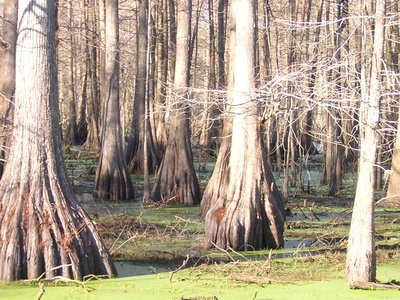
Bald cypress
Ancient, buttressed trunks with knobby “knees” make cypress unmistakable. Leaves turn rusty in fall, cones persist year-round. Look for them in the deepest, long‑flooded sloughs near the boardwalk; they form some of the park’s most iconic, towering trees.
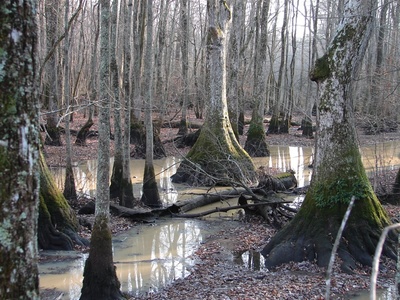
Water tupelo
Swamp‑adapted tree with swollen trunk bases and conical form, often in standing water. Summer bears small bluish drupes eaten by wildlife. Find it in permanently flooded channels where its fluted trunk and water‑tolerant roots stand out.

Blackgum (Black tupelo)
Glossy leaves that turn brilliant red or purple in fall are a giveaway. Prefers slightly drier levees and hummocks within the floodplain. Notable for late autumn color and wildlife‑friendly fruit.
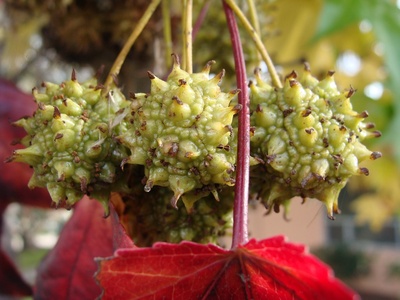
Sweetgum
Star‑shaped leaves and spiky seed balls are distinctive; leaves turn spectacular reds and purples in fall. Widespread across levees and slightly higher ground; common component of the old‑growth canopy.
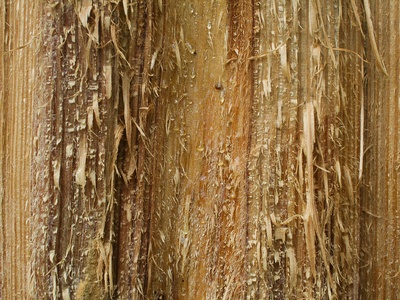
Loblolly pine
Tall, straight pine often on drier ridges inside the floodplain. Needles in bundles of three and flaky bark help ID. Home to some of the park’s champion pines, visible from higher boardwalk sections.
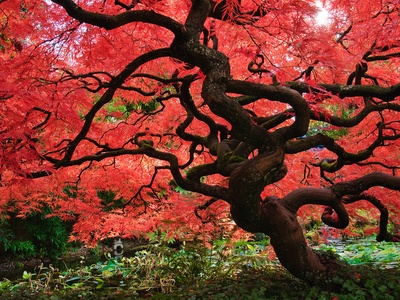
Red maple
Variable leaves often with three lobes; brilliant red fall color in wetter areas. Extremely common across flooded flats and levees; tolerates a wide moisture range and flowers early in spring.
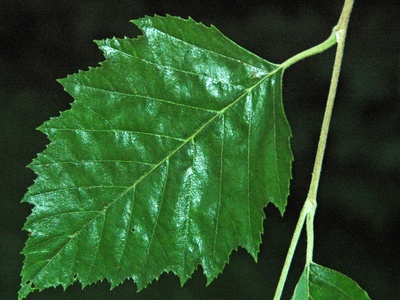
River birch
Peeling, cinnamon‑colored bark that flakes in papery strips makes this tree easy to spot along water margins. Prefers banks and levees where soil is moist; catkins appear in spring.
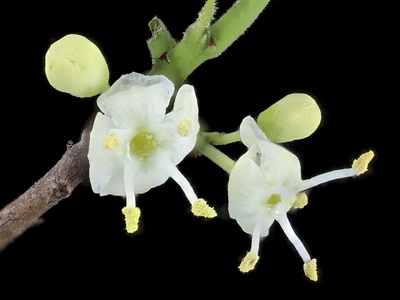
American holly
Evergreen with glossy, spiny leaves and bright red berries in winter. Common in shaded understory pockets and levee slopes; berries provide winter interest and food for birds.
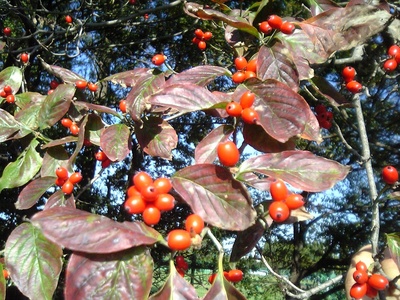
Flowering dogwood
Spring displays of four showy white bracts and layered branching identify this understory tree. Look for it on levees and drier edges; notable for spring blossoms and red fall berries.
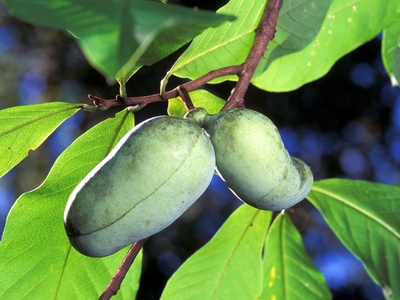
Pawpaw
Tropical‑looking large leaves and low, clustered trunks. Spring bears maroon flowers, summer produces custardy fruit. Common in shaded understory thickets near water where pollinators are scarce but fruit is wildlife food.
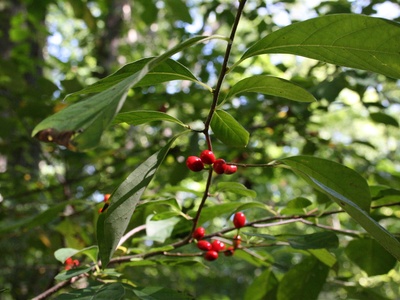
Spicebush
Small shrub with aromatic crushed leaves and yellow spring flowers before leaves emerge. Berries in fall are eaten by birds; look for it in damp understory and along trail edges.

Switchcane
Native bamboo forming dense stands along levees and sloughs. Tall, jointed canes and persistent clumps identify it. Important habitat element historically; watch for waving cane along boardwalk corridors.

Buttonbush
Round, pin‑cushion white flower heads in summer attract butterflies and bees. Found right at water margins and in seasonally flooded depressions; notable for distinctive spherical blooms and wetland affinity.

Poison sumac
Compound leaves with 7–13 smooth leaflets and reddish stems; grows in standing water. Extremely itchy sap causes contact dermatitis; commonly found in wet, low spots—stay on boardwalks.
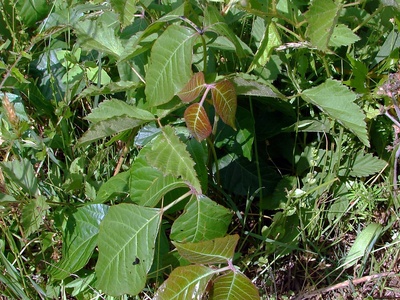
Poison ivy
Leaves of three compound leaflets, variable growth as vine or groundcover. Flowers and white berries late summer to fall. Ubiquitous in the park—learn its look to avoid contact.

Wax myrtle
Aromatic evergreen shrub with waxy bluish berries used by birds. Leaves aromatic when crushed; common on drier levees and transitional zones where it forms dense thickets.
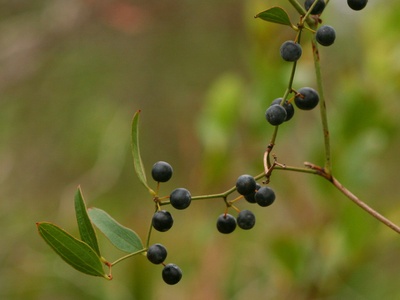
Laurel greenbrier
Evergreen, leathery leaves and stiff, spiny vines that create impenetrable tangles. Small inconspicuous flowers and black berries later. Very common in swamp understories and notable for its thorny, climbing habit.
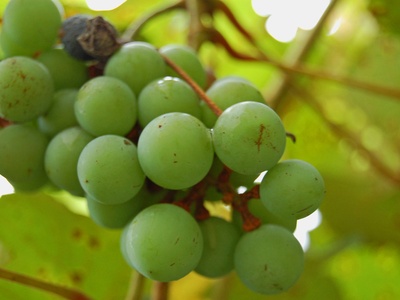
Muscadine grape
Thick leaves and edible round grapes ripening in late summer distinguish this native vine. Climbs trees along levees and edges; birds and park visitors enjoy the sweet fruit.
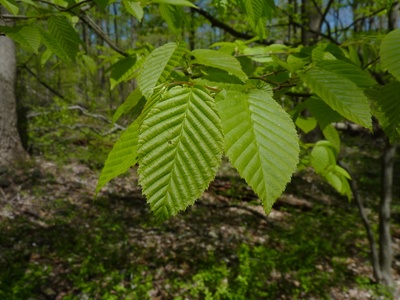
American hornbeam
Smooth, sinewy, muscle‑like trunk and fluted bark make this small tree recognizable. Prefers shady, damp levee spots; notable for hard wood and delicate fall yellow color.

Sassafras
Distinctive mitten‑ and three‑lobed leaves and aromatic crushed scent identify sassafras. Bright yellow to orange fall color and early spring leafing make it noticeable on drier levee ridges.
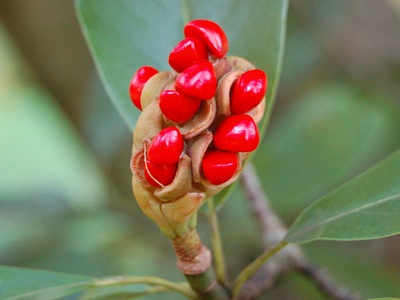
Sweetbay magnolia
Narrow, glossy green leaves often with silvery undersides and fragrant white flowers in late spring and early summer. Found in wet margins and shallowly flooded areas; notable for delicate citrus scent.
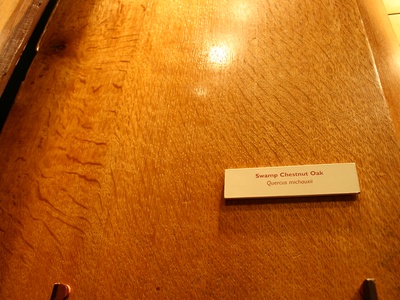
Swamp chestnut oak
Large oak with rounded leaves and deeply ridged bark, typically on slightly higher levees within the floodplain. Produces large acorns favored by wildlife; a stately canopy tree of the park.

Willow oak
Narrow, willow‑like leaves and smooth gray bark help ID this oak. Common on levees and edges; provides foliage and acorns for many animal species.
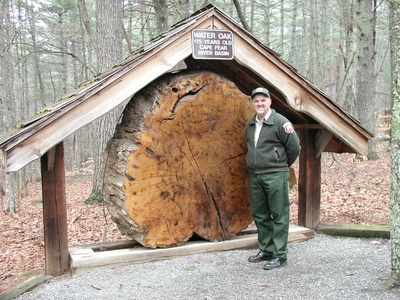
Water oak
Variable, spatulate leaves and medium size; tolerates wet soils. Look for it scattered through the floodplain and on transitional levees; notable for its fast growth in disturbed spots.

Overcup oak
Adapted to very wet soils with deep cups on acorns that often enclose much of the nut. Found in frequently inundated stands within the floodplain; a true swamp oak.

Cherrybark oak
Tall oak with deeply lobed leaves and flaky bark on mature trees. Prefers levee ridges and well‑drained hummocks; notable as a large canopy tree in mature stands.

Green ash
Compound leaves and opposite branching identify ash; common on levees and stream banks. Historically abundant in floodplains—now monitored due to emerald ash borer impacts.
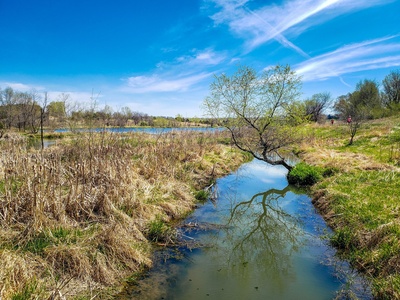
Black willow
Narrow willow leaves and often leaning trunks along channels make this tree easy to spot. Found right along slough edges and river margins; notable for rooting from cuttings and rapid colonization.

Black cherry
Dark, flaky bark and clusters of white spring flowers identify this species. Produces small cherries eaten by birds and mammals; common on levees and drier pockets.
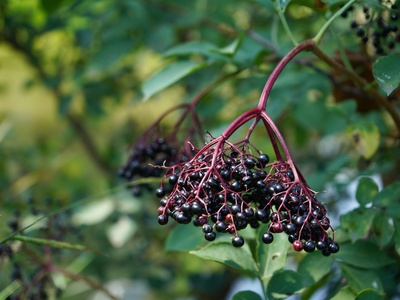
Elderberry
Multi‑stemmed shrub with flat clusters of white spring flowers and dark berry clusters in summer. At the park’s edges and levees, a magnet for pollinators and birds that eat the fruit.
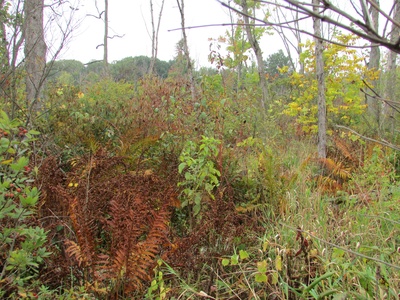
Cinnamon fern
Large, two‑toned fern with upright cinnamon‑brown fertile fronds in spring. Common in wet microhabitats near sloughs and along boardwalks; eye‑catching in spring and early summer.

Royal fern
Graceful, triangular fronds and brown fertile segments on lower fronds. Found in saturated soils along swamp edges and wet depressions; notable for old‑growth wetland fern communities.
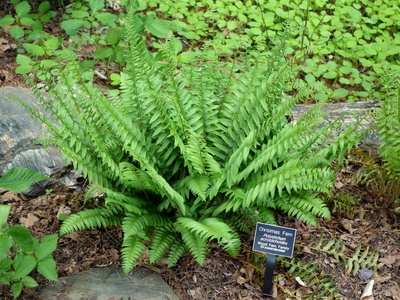
Christmas fern
Evergreen leathery fronds stay green through winter, making ID easy near shaded levees. Common in cool, moist understory niches; notable as a familiar forest fern year‑round.
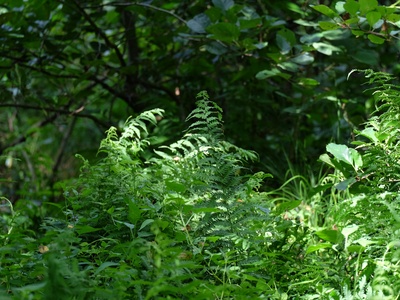
Marsh fern
Lush green fronds in wet meadows and marshy depressions. Flowers absent; identify by frond shape and habitat. Common in saturated soils adjacent to open water.

Resurrection fern (epiphytic)
Tiny, leathery fronds cling to cypress bark and curl during drought, unfurling after rain—hence the name. Look on trunks and high limbs; a neat epiphyte showing microhabitat diversity.
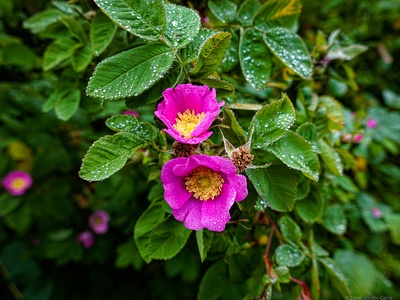
Swamp rose
Pink summer flowers followed by red hips in fall. Thorns and pinnate leaves help ID. Common in wetter thickets and edges; notable for providing cover and food for birds.

Common rush
Clump‑forming rush with cylindrical stems and tufted growth in shallow water. Flowers small and brownish; look for it on pond edges and seasonally flooded flats.
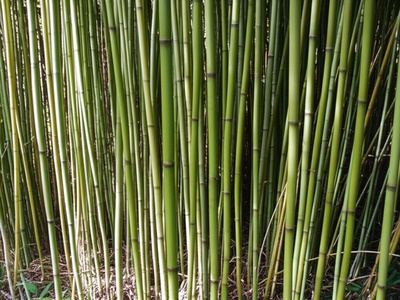
Switchcane (reed)
Smaller native cane with dense clumps forming understory thickets. Important for wildlife and historic human uses; identifiable by jointed hollow stems and dense stands near levees.

Spatterdock (yellow pond‑lily)
Floating leathery leaves and cup‑shaped yellow flowers in summer. Found in slow, open water pockets within the floodplain; notable as pond wildlife habitat and nectar source for insects.



